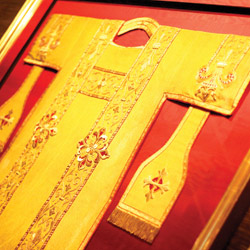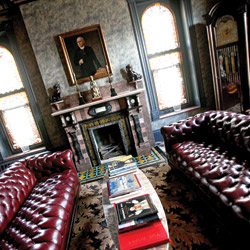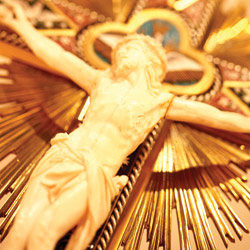The bishop’s home is full of storied treasures few have had the opportunity to see.
Sweeping staircases on either side of the entrance make visitors and passersby keenly aware of one of Peoria’s oldest homes. Predating the Civil War, the residence of the bishop of the Catholic Diocese of Peoria, located at 607 N.E. Madison Avenue, is a sight to behold. While the building itself is a magnificent example of a well-kept Victorian home, it is not the only item of interest here—also significant are the holy artifacts of former bishops and saints-to-be on display throughout. Monsignor Stanley Deptula, vice chancellor of the diocese, led me on a tour of the home, relating the history of the residence and its contents as we went.
 Every Thing Has a Story
Every Thing Has a Story
Walking in the front door, surrounded by rich woods and ornate stained glass, I was absorbed by the grandeur of the building, with its custom-made radiator covers and floor-to-ceiling mirrors, intricate carpets and elaborate crown moldings. Throughout the house, beautifully restored ceilings showcase Waterford crystal chandeliers from Ireland, giving life to all that lies beneath.
As we entered a sitting room, we encountered a beautiful painting of the Nativity. Deptula explained that it’s an oil painting on wood from the Venetian School, a style of painting characterized by the exploration of light and use of warm colors, dating between the 14th and 18th centuries. This particular piece, he said, is several hundred years old, and its journey to the Diocese is somewhat unclear. It’s believed that an army chaplain brought it back from Europe at some point; it was later discovered in the basement of a country church and given to Bishop Joseph Schlarman in the 1930s or ‘40s. A large gilt frame was made for it, and the painting hung in the cathedral until the current bishop, Bishop Daniel Jenky, moved it here in order to dedicate more space in the cathedral to the Virgin Mary.
In the same room sits a pair of distinctive green chairs. Custom-built for the house, they’re not antiques, but were designed to replicate the type of chairs that porters would have occupied in the entrance halls of Victorian homes. With their curved backs and hoods, these chairs were fashioned to protect those stationed at the front door from cool drafts.
Walking through the first-floor hallway, we passed by an antique chasuble and stole, garments worn by priests when they celebrate Mass. The chasuble resembles a long tunic and is the outermost vestment. Underneath it, the long stole is hung around the priest’s neck and down his chest. An example of exquisite needlework from the late 19th or early 20th century, these vestments were framed and hung on the wall.
We then headed upstairs to see what treasures awaited us on the second floor. As we approached the top of the stairs, we saw more antique vestments hanging on the walls—these were a gift to Bishop Spalding on the 50th anniversary of his ordination to the priesthood nearly a century ago. The complete set of vestments is adorned with spun gold embroidery and show slight wear and tear.
Down the hall in the community room sits a coffee table containing several medals given to Bishop Jenky by various organizations. One signified his status as a Knight of Malta, a Christian military order which traces its roots back to the crusades; another identifies the bishop as a Knight of the Holy Cross of Jerusalem. The table also contains a pectoral cross—a large cross made of precious metal that’s worn just below the heart—that Pope John Paul II gave to Jenky when he was a young bishop.
 The Bishop’s Private Quarters
The Bishop’s Private Quarters
Monsignor Deptula then took me into the bishop’s personal apartment. Bishop Jenky’s coat of arms hangs over the double-door entrance; to the left is an icon of Saints Stephen and Lawrence—“the two great deacon saints,” explained Deptula—given to the bishop by the deacons of the diocese about five years ago.
Just inside the apartment is the bishop’s private chapel, which was designed by Harry Breen, an artist from Champaign who was commissioned for the task during a renovation in the late 1990s. Breen was responsible for constructing the altar on which the bishop celebrates his private Masses, as well as the doors of the tabernacle. He also created the depictions of the four evangelists—Matthew, Mark, Luke and John—that hang in the four corners of the chapel. Breen was later commissioned to paint two icons—one of Our Lady of Peoria, the other of Saint Joseph, Patron of the Church.
The bishop’s chapel houses numerous other items of interest, including relics of each of the Apostles. These small pieces of the saints’ bones are displayed in a special case called a reliquary, made of gold and glass. In another reliquary sits a piece of the True Cross, on which Jesus was crucified.
The bishop’s chapel contains one more relic—that of Blessed Brother Andre, a member of the Holy Cross who will be canonized this October, which rests next to a statue of the saint.
The crucifix in the chapel was a gift to Bishop Schlarman and contains several mosaics depicting scenes of Rome and silver angels holding various tokens, such as Saint Veronica’s veil marked with the face of Christ. While little else is known about the history of this piece, its beauty is something to marvel at.
The chapel also contains Bishop Schlarman’s personal prie-dieu (pronounced “pray-doo”), the kneeler he used during his private prayer. Deptula speculated that it may have been a gift, as the names of several priests have been carved into its sides.
Leaving the chapel, we passed by Bishop Spalding’s faldstool, the bishop’s traveling throne, in the hallway. This piece of furniture is essentially an exquisite folding chair that would go with the bishop in his carriage as he traveled throughout the diocese. Next to the faldstool stands Bishop Schlarman’s crosier, the staff or shepherd’s crook he carried when conferring sacraments or celebrating liturgies.
We entered the bishop’s personal sitting room, where a painting of Bishop Spalding hangs over the fireplace. The ornate, stained-glass windows in this room, originally installed in the bishop’s first-floor office, were moved upstairs during one of the building’s renovations.
 Sharing the Space
Sharing the Space
Next, we ventured up a staircase that’s tucked away behind a locked door and onto the third floor to what’s become merely an attic used for storage. Details such as a coffered ceiling and paneled walls make it clear that the room at the top of the stairs was once an elegant parlor or game room. This part of the house was not restored during renovations, as the ductwork that runs along the floor would have been costly to move.
The remainder of the attic contains a series of small rooms and once served as a boarding house for priests. In the days when traveling was done by horseback, visiting priests were often on the road for several days, and these rooms eased their journey. It’s evident from the elegant wallpaper and door frames that this was once a lovely part of the house.
We then headed back downstairs to the main level, part of which, Deptula pointed out, is set aside as a convent for the Franciscan Apostolic Sisters from the Philippines, who have been serving the bishop of Peoria for over 20 years. The sisters take care of the bishop and his home and offer hospitality to priests and visitors. They certainly stay busy, as Bishop Jenky welcomes many visitors to his home, often dining with priests from around the diocese and allowing local groups to use the home for fundraisers.
At the end of our tour, as I headed out the door and down the grand staircase, I was again struck with a sense of awe. The bishop’s home had come alive, all of the artifacts within giving life to those who had left them behind; the walls themselves telling stories of how the diocese has grown throughout the years. No longer simply a building, the bishop’s home is more like a living museum. a&s



